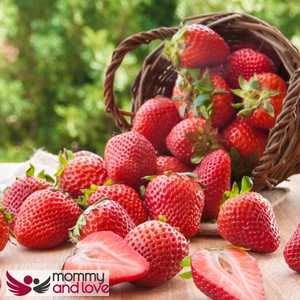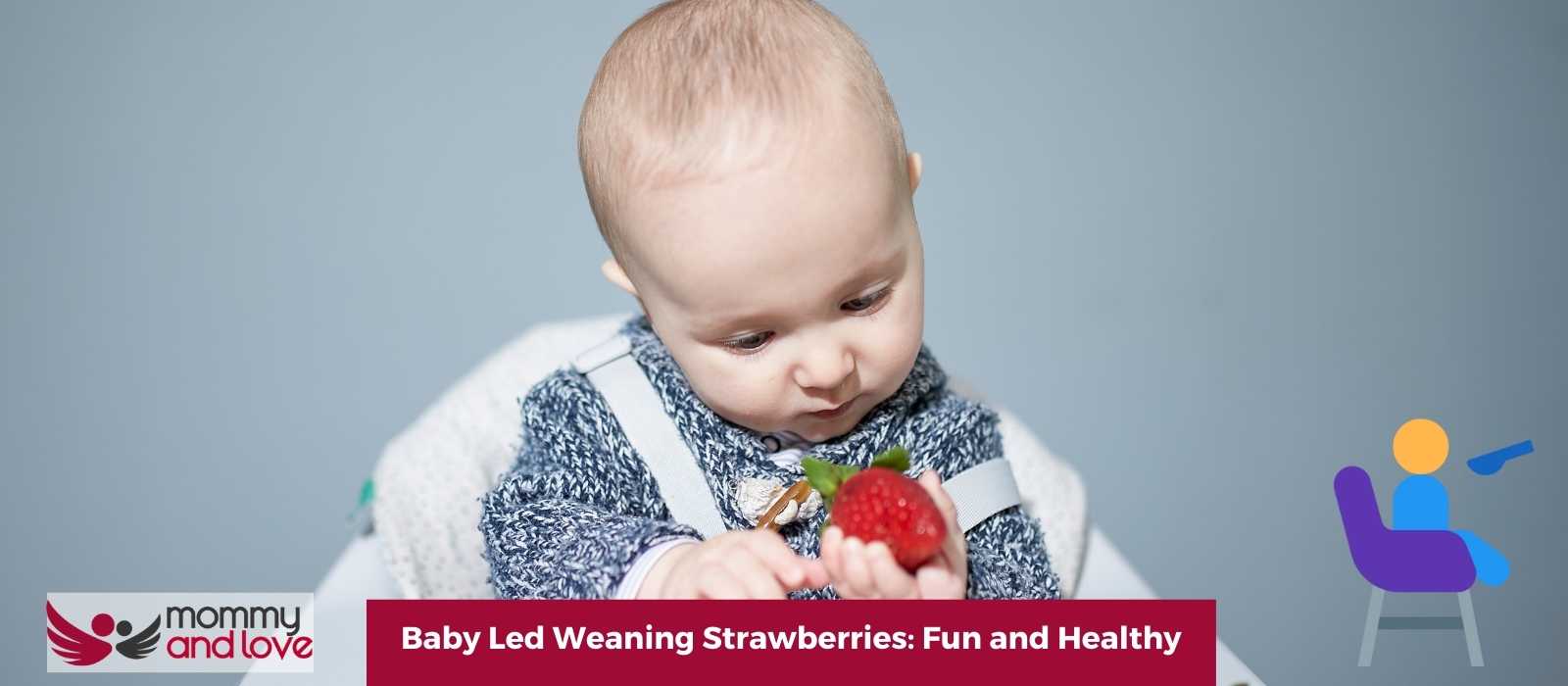Introducing solids to a baby is an important milestone, and there are many different ways to do it. Some parents opt for traditional spoon-feeding, while others choose baby-led weaning, which allows the baby to self-feed with finger foods.
Baby Led Weaning (BLW) with strawberries is a great way to introduce your child to solid foods. Strawberries are soft and easy to chew, making them a good choice for babies who are just starting out.
In this blog post, we will discuss the benefits of BLW with finger food such as strawberries and give you some tips on how to get started!
Are Strawberries Healthy?

Strawberries are not only delicious but are also packed with nutrients. Eating strawberries is a good way to get Vitamin C, fiber, and antioxidants.
They have been shown to improve heart health, brain function, and immunity. Strawberries are also low in sugar and calories, making them a healthy snack option for kids and adults alike.
Benefits of Baby Led Weaning with Strawberries
There are many benefits to BLW, and strawberries can be a great way to start.
BLW allows babies to develop their own eating habits and explore new flavors and textures at their own pace. It also promotes self-confidence and independence, as well as fine motor skills.
When Can Babies Eat Strawberries?
Most babies can start eating solids around six months old. And depending on your baby’s age, you can either give him cooked or raw strawberries. However, every baby is different, so it’s important to talk to your pediatrician before starting any new foods and to obtain more baby-led weaning information.
If you’re introducing strawberries through BLW, you can offer them as early as eight months old.
Can Babies Eat Strawberry Jam?

Most strawberry jams have sugar in them, which can cause cavities. Talk to your pediatrician before feeding your baby any type of jam.
They may have suggestions for sugar-free or no-sugar-added options. You can also make your own jam at home without any added sugar.
Just be sure to check the labels on store-bought jams to see how much sugar has been added. Babies under one year old should not have any foods with added sugar.
If you do give your baby jam, make sure to brush their teeth afterwards. You can also try diluting the jam with water to reduce the amount of sugar your baby is consuming.
Never give your baby honey, as it can contain harmful bacteria. Stick to giving them fruit in its whole form or pureed until they’re at least one year old. After that, you can start introducing jam and other sugary foods into their diet in moderation.
Is Strawberry a Common Allergen?
Strawberry fruit is not a common allergen, but some babies can be allergic to the fruit’s acidity, especially those with pollen food allergy syndrome. Interestingly, white strawberries are less likely to cause an allergic reaction due to low strawberry protein content.
If your babies develop an allergy to strawberries, talk to your pediatrician. Signs of an oral allergy syndrome include rash around your baby’s mouth, hives, trouble breathing, irritability, swelling and itchiness. They can perform a skin prick test or blood test to determine if your child is allergic.
If your baby is showing allergic reactions to strawberries, stop giving your baby strawberries. There are plenty of other foods you can try. Talk to your pediatrician or a certified feeding therapist for more ideas.
Are Strawberries A Common Choking Hazard for Babies?
Strawberries are not a common choking hazard for babies. However, as with any new food, it’s important to supervise your child while they are eating and be sure to cut the whole strawberries into small pieces. Or if you are worried about choking hazards, avoid large strawberries and serve mashed strawberries instead.
If you’re concerned about your child choking, talk to your pediatrician or a certified feeding therapist.
How to Prepare Strawberries Baby Led Weaning
Now that we’ve answered some common questions about adding juicy strawberries to your baby’s diet, let’s give you some tips on how to get started and prepare strawberries.
When introducing any new food, it’s important to start slowly. Offer your child a small piece of strawberry and see how they react. If they seem interested, you can give them a little more. Cutting strawberries in age-appropriate sizes is also important even if your baby’s pincer grasp has been developed.
It’s also important to be patient and not get frustrated if your child doesn’t take to strawberries right away. Some babies need to try a new food several times before they will eat it.
If you’re looking for some fun and creative ways to serve strawberries, here are a few ideas:
- Wash a whole strawberry properly, regardless of whether you have organic strawberries or not.
- Cut a whole strawberry into small bite-sized pieces and serve quartered strawberries with yogurt, cottage cheese or baby cereal.
- You can cook strawberries with other raw fruits. Other strawberry recipes include making a fruit salad with strawberries, bananas, and apples.
- Add diced and chopped strawberries to pancakes or waffles. Or make strawberry oatmeal.
- Blend strawberries with peanut butter. Or top a PB&J sandwich with sliced strawberries.
What Are the Different Strawberry Varieties?
Now that you know all about the benefits of BLW with strawberries, let’s talk about the different types of strawberries you can find at the store.
There are three main types of strawberries: June-bearing, overbearing, and day-neutral.
June-bearing
June-bearing strawberries are the most common type. They are typically red and have a sweet flavor.
Overbearing
Overbearing strawberries are larger and more tart than June-bearing strawberries. They are usually red, but can also be yellow or white.
Day-neutral
Day-neutral strawberries are the smallest type of strawberry. They have a sweeter flavor and are often used in desserts.
No matter which type of strawberry you choose, your child is sure to enjoy it!
How to Make Strawberry Puree?
If you’re looking for a simple and easy way to introduce strawberries to your baby, try making strawberry puree!
Here’s what you’ll need:
- One pound of fresh strawberries
- Water
- A blender or food processor
To make the puree, start by washing the fresh or frozen strawberries. Then, remove the stems and leaves of the whole berry.
Next, cut strawberries into small pieces. If you’re using a blender, you can leave them whole. If you’re using a food processor, you may need to cut strawberries into smaller pieces. Or you can also mash half of the strawberries.
Once the strawberries are cut up, add them to the blender or food processor with a little water. Blend or process the strawberries until they reach the desired consistency. You can add more water if you want a thinner puree.
Once the puree is finished, it’s time to feed it to your baby! You can offer it to them by spoon, or put it in an infant feeding bottle or add them to a warm cereal. You can store the remaining puree in an air-tight container and store it in the fridge for future meals.
Conclusion
We hope this blog post has given you everything you need to know about baby-led weaning with strawberries!
Remember, it’s important to start slowly and be patient. Introduce solid food to your baby, one food at a time. If your child doesn’t take to strawberries right away, don’t get discouraged. Offer strawberries at a later time when your child’s age is ready for them in her feeding journey.
There are plenty of other berries and foods you can try. And, if you’re looking for some fun and creative ways to serve strawberries, we’ve got you covered!
If you have any questions or concerns, be sure to talk to your pediatrician or a certified feeding therapist.

This article was written by Sandra Baker – full time writer and the mother of four amazing kids (including twins!)
She’s also a breastfeeding counselor and has spent years helping new parents learn how to care for their children. When she’s not writing or caring for her children, Sandra likes to spend time reading and taking walks with her husband.




